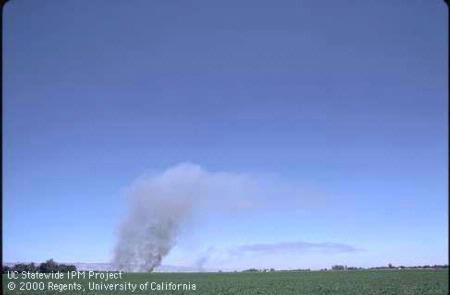
Posts Tagged: air
Calculate Your VOC Emissions
As summer continues to heat up, keep in mind that regulations remain in effect to reduce the volatile organic compounds (VOCs) that can be emitted into the atmosphere by pesticides and other harmful chemicals and contribute to the amount of ozone or smog in the environment.
Calculators from the Department of Pesticide Regulation (DPR) that determine the VOC emissions from fumigant and non-fumigant pesticides before application are available to help growers, pest control advisers, and pesticide applicators comply with the regulations. The UC Statewide Integrated Pest Management (IPM) Program provides a link to these calculators from each of the treatment tables in the UC Pest Management Guidelines. Click on the Air Quality – Calculate emissions button.
Take steps to reduce VOCs. Avoid emulsifiable concentrate (EC) formulations as they release the highest VOC emissions. Pesticide control advisers and growers can also reduce VOC emissions by employing IPM practices such as using resistant varieties, traps, exclusion, and biological control. When using pesticides, spot-treat and seek low-emission materials. Solid formulations, such as granules or powders, are best.
Check the fact sheet on the DPR web site for the most up-to-date-information on VOC restrictions and regulations.

air emissions button
Why rising smoke from an orchard heater spreads out when it hits the ceiling
If you have ever wondered why smoke rising during calm weather when there is a "ceiling", where there is warm air sitting on cold in an inversion, here is an explanation from our biometeorologist Rick Snyder at UC Davis.
The smoke rises because the heated air is less dense than the surrounding air. As it rises, it cools due to air expansion, cooling due to radiation from the heated air, and entrainment of surrounding air into the rising smoky air. In an inversion, temperature increases with height but the rate of temperature increase with height decreases with height above the ground until it becomes isothermal and then starts to decrease with further height. As the smoky air rises, it cools and the density decreases. Eventually, in a strong inversion, it will reach a level where the density of the smoky air is the same as the surrounding air and it will stop rising. Since the rising air continues to add mass (air) to the level where the density is the same, it has to spread out and mix with the ambient air with the same density at that level. You can't increase the mass of air at the point where the smoky air reaches a level having the same density, so the smoky air spreads out horizontally. If air temperature decreases with height, it is called a lapse condition and it typically the atmosphere cools at about 1oC per 100 m. The smoky air would have to cool much faster than 1oC per 100 m to cool to the point where the density of the smoky air and surrounding air is the same. The smoky air will be warmer than the surrounding air and will continue to rise and eventually entrain with the surrounding air and dissipate. You will see the smoke spread out in inversion but it will continue to rise and dissipate in a lapse condition.
There you go.

smoke
